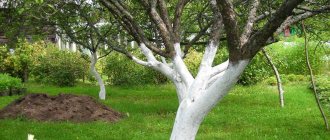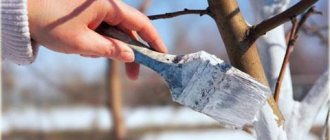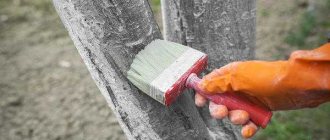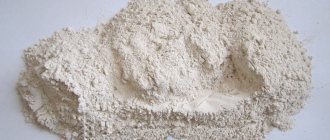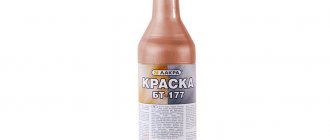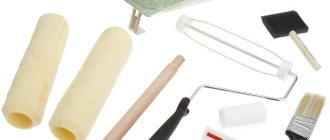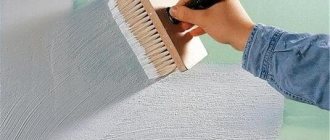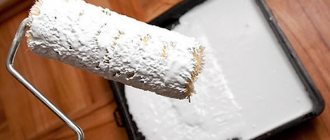Rules for autumn whitewashing of fruit tree trunks
With the onset of cold weather, when the fruit trees have already given up their harvest and shed their foliage, the garden seems to freeze, plunging into a deep sleep until the first spring rays of sunlight.
This period is the best time to carry out basic activities to prepare the garden for winter. Whitewashing fruit trees in the fall not only increases the yield for the next season, but also protects the garden from many troubles during the cold season. Autumn whitewashing of fruit tree trunks performs several functions at once:
- Reflection of the sun's rays. The winter sun is deceiving. Its rays, especially during the thaw period, often cause burns on the bark of trees. Trunks coated with white lime are able to reflect the sun's rays, thereby preventing overheating and cracking of the bark.
- Protection against temperature changes. Whitewash acts as a kind of thermal insulation “coat”, thanks to which the tree trunk does not overheat during the winter day and does not freeze at night. Such a “fur coat,” acting as an excellent protection for the tree from frost, prevents the formation of frost holes on the bark, which serve as an excellent environment for the development of pathogenic spores and other pathogens.
- Destruction of pathogenic microorganisms. The lime and fungicides included in the composition for whitewashing fruit trees, penetrating deeply under the plant bark, can have a destructive effect on colonies of harmful insects and destroy microorganisms and fungal spores.
To bleach or not to bleach trees in the fall?
The older the tree, the more difficult it becomes for it to resist harmful influences. Over the years, the bark of a tree becomes rougher, cracks, scab and other troubles appear on it. All this leads to the fact that the degree of protection of the tree itself decreases. Whitewashing trees reflects light, and this is important in early spring, when the sun is already shining brightly, but the snow has not melted, the ground has not thawed, and the trees have not yet woken up. During the day the temperature can warm up to +20 °C, and at night frosts return. It turns out that the bark of the tree heats up during the day, and an invisible process of sap flow starts inside the trunk. When it gets cold at night, the sap that is inside the tree turns into ice again. Such vibrations can cause the tree to “tear” from the inside, and cracks—frost holes—will appear on the trunk. In this case, whitewashing plays the role of a light reflector, preventing the trunk from overheating in the sun, therefore, as a rule, whitewashed trees wake up later.
Variety of choice of whitening compounds
Option #1 – homemade whitewash
The simplest and cheapest option for making a whitening composition is a solution of slaked lime in simple white. The ratio of the components of such a solution is: 2 kg of freshly slaked lime, 300 g of copper or 500 g of iron sulfate per 10 liters of water. Adding 1 tbsp to the solution. A spoonful of carbolic acid can additionally protect trees from attacks by hares and mice.
The lime whitewash solution is stirred in a bucket until it has the consistency of thick sour cream.
Many gardeners have been using this solution since time immemorial. Although the degree of protection of such whitewash is not high enough, due to its affordable price and ease of manufacture, it remains one of the most popular among most gardeners.
In the absence of the opportunity to treat the surface of the trunk with a whitening compound, you can always use another old-fashioned method - coat the trunks with a regular mixture of clay and mullein. To do this, you need to mix 2 kg of lime, 1 kg of clay, 1 kg of cow dung and 250 g of copper sulfate in a container.
Option #2 – ready-made garden mixtures
Garden mixtures based on lime and clay allow the tree to “breathe”.
If lime mortars can only be applied to mature trees, then clay mixtures can also be applied to young seedlings without damaging growth
The only drawback of this solution is that during the winter it is gradually washed off from the trunk. Therefore, it is advisable to whitewash fruit trees again in early spring.
Option #3 – acrylic and water-based paints
Acrylic paint, which contains antifungal and bactericidal components, effectively protects tree trunks from any pathogens.
Such whitewashing is good if the owner does not have the opportunity to promptly check the condition of the tree trunk: whether the protective paint remains on them after winter
Advice. Acrylic whitewash is not a “breathable” base and therefore it is not advisable to use it on young seedlings.
Water-based paint is effective in combating winter frosts, but it is not able to protect the tree from harmful insects. Therefore, before using it, copper-containing components are added to the paint composition.
How to cover a cut on an apple tree?
After the cleaned and disinfected cut on the apple tree dries, it must be covered with a special product . This is done to seal damage to close the entrance to pests, bacteria and fungi.
In addition, in the place of an unprotected cut, the branch may begin to dry out. This happens because:
- Sap flow is disrupted, nutrients do not reach the part of the branch that is located above the damage;
- Moisture evaporates through the wound.
An unprotected wound is prone to cracking, and sometimes the cracks are deep. A hollow may form in the place where the saw cut damaged the bark of the apple tree.
The following is used as putty:
- Garden var;
- A thick mash of clay and mullein;
- Oil paints on natural drying oil;
- Cement mortar – for particularly large damages;
- Water-based paints;
- Artificial bark (balm - varnish).
Garden varnish can be purchased at the store, or you can prepare it yourself. To prepare it, wax, rosin and fat are used.
The wax does not allow water to reach the wood and does not allow the putty to drain from the wound. The stickiness of rosin allows the varnish to firmly bond to the wood. Fat prevents the putty from cracking in any weather.
Any unsalted fat is suitable. You can replace it with vegetable oil or natural drying oil. Turpentine is suitable instead of wax.
- Take 1 part each of rosin and fat, and 2 parts of wax. Rosin, wax and fat are melted separately and then mixed. This solution is slowly poured into cold water. Take out after hardening;
- Also mix 20 parts of paraffin, 4 parts of rosin and 1 part of drying oil;
- Rosin and wax 2 parts each, vegetable oil - 1;
- Rosin 1.5 parts, oil - 2. Heat, mix and pour in 1 part of turpentine. It is important to do this away from the fire.
Rules for whitewashing work
You can start whitewashing trees in the second half of autumn, when the rainy season has already passed and the air temperature has settled around 2-3 °C. It is better to choose a fine, dry day for whitewashing.
Whitewashing can only be done on trees that have entered the fruiting season. Young seedlings purchased in the autumn season are not whitened for the winter, since the protective paint only clogs the pores of the tree and does not allow the plant to fully develop, leading to its death.
One or two year old seedlings are simply tied with any covering material. Agrofibre is best suited for these purposes.
Plastic film is far from the best choice, since by retaining moisture, it provokes the development of mold and fungi in the covered area of the trunk.
Preparatory work
Before whitewashing, it is necessary to carefully inspect the trees to eliminate breeding grounds for pathogens. Tree trunks and the lower bases of skeletal branches need to be cleared of dried and diseased bark, old growths and moss. Although lichens do not harm the bark of trees, they clog them. You can get rid of lichens by “washing” the trunks with a solution consisting of 1 kg of salt, 2.5 kg of ash and 2 pieces of laundry soap. All ingredients must be mixed and poured into 1 bucket of hot water, brought to a boil and cooled.
The trunk can be cleaned with wooden spatulas, metal scrapers or brushes, or use serrated saws for this.
You need to work with tools very carefully so as not to damage the plant bark. After cleaning, all wounds and damage must be treated with garden varnish.
If you don’t have garden varnish on hand, you can make your own wound-healing putty. To do this, you need to mix 2 parts clay with 1 part manure, adding copper sulfate and straw dust to the mixture. The putty should be as thick as sour cream.
Carrying out whitewashing of trunks
You can whitewash trees using either a regular brush or a spray gun. However, when working with this convenient device, you should be prepared for the fact that paint consumption will be an order of magnitude higher compared to the traditional whitewashing method. To make painting easier, it is advisable to prepare brushes in advance that match the thickness of the trunk and skeletal branches.
How to treat a cut apple tree? Disinfection methods
Damage to an apple tree of any size must be treated with a disinfectant so that pathogens do not enter the wound.
So, what to cover a pruned apple tree with? Potassium permanganate and preparations containing copper or iron sulfate are suitable for these purposes. All solutions are prepared immediately before processing apple trees:
- 50 grams of copper sulfate are diluted in 1 liter of very warm water;
- Several grains of potassium permanganate are diluted in warm water. The color should be bright pink;
- 30 grams of iron sulfate are diluted in 1 liter of water;
- Prepare a 3% Bordeaux mixture . To do this, 30 grams of copper sulfate are dissolved in 0.5 liters of warm water. Separately, dilute 30 grams of lime in 0.5 liters of water. The vitriol solution is slowly poured into the milk of lime in a very thin stream, stirring constantly. The finished Bordeaux mixture has a beautiful blue color.
To apply the solution, use any brush. The weather at the time of processing should be dry and windless. Be sure to use rubber gloves.
To disinfect damaged wood, you can use balms with fungicides, which are sold in gardening stores.
SADOVAYA
BS-01
GARDEN PAINT FOR TREES
Properties:
the paint is water-based. White, matte, antiseptic, fire and explosion proof, gas permeable, odorless. Does not contain solvents or harmful emissions. Purpose:
Designed for painting fruit, ornamental trees and shrubs. The product is environmentally friendly, forms a vapor-permeable “breathable” coating that can protect plants from diseases, pests and sunburn, and increase the winter hardiness of trees.
Garden paint is an effective tool in the fight against crops and pests.
Garden paint is not a material suitable for facade work. In the life of gardeners, it has another, important purpose. This product is used primarily for whitewashing and to protect trees from small rodents, hares and other tree bark lovers. Some lovers of country work, out of habit, use old methods and means of whitewashing, proven by many generations. But today, every manufacturer of paints and varnishes has a more modern product in its range. Those who have once used it no longer return to old methods, since the effectiveness of such a chemical product is much higher.
Paint for garden trees can also be used as a remedy when they are infected with black cancer. This type of building material is made on the basis of water, antiseptic, acrylic copolymers and chalk. In addition, there are also agronomic additives, which, one might say, are a source of life-giving force for the tree.
Actually, such a paint and varnish material is an external product. As a rule, it is only white. Gardeners use this product to protect trees from damage from sunburn and frost damage. It doesn’t matter how garden paint is applied to the tree trunk: with a brush, roller or spray - it can protect even sensitive heat-loving plants from icing. In addition, such a station wagon is also used for therapeutic and prophylactic work, preventing infection or damage to trees and shrubs by harmful insects. All chemicals in this category are completely safe and do not cause any harm to trees or shrubs. However, this product perfectly destroys pests that are dangerous to the tree.
Paint for garden trees, based on acrylic latex, is deservedly popular in its segment. The huge advantage that acrylic paint has is its rapid absorption and the formation of a durable, breathable film on tree trunks.
It is very interesting that paint for garden trees can be used for other purposes. Although it is intended primarily for wood, it is also used for other purposes. For example, experienced summer residents paint the walls or roof of a greenhouse to protect the plants in it from sunlight.
In addition, wooden garden furniture painted with this paint will also be protected from pests. For example, an outdoor wooden bench, a favorite resting place for summer residents after exhausting work, will delight you with its convenience longer, despite the unfavorable external environment. This is due to the fact that garden acrylic paint forms a durable film, which will protect it from moisture. And, importantly, garden furniture treated with this product lasts longer and looks great against the backdrop of trees with beautifully whitewashed trunks.
The sale of such a product for garden trees, shrubs and even furniture is carried out not only in construction and finishing materials stores. This paint and varnish product can also be purchased in gardening stores. Recently, a new trend of shopping through an online store has emerged. These services that offer goods and services are very convenient. Moscow was the first to appreciate such a convenient shopping option, because this type of shopping frees you from exhausting shopping trips with a heavy load in your basket. In addition, most of these services offer free and convenient delivery.
The quality of garden paint purchased from an official manufacturer’s online store always guarantees quality and absence of counterfeiting. After all, in order for fruit trees or shrubs to delight with their young shoots or fruits, they need high-quality care products. However, it is not enough to purchase high-quality paint and varnish material - it still needs to be used correctly.
Before applying such paint, the surface to be treated must be properly prepared. First of all, it is necessary to remove all types of contaminants from the surface: dust, old lime paint, moss and lichens, if any. Dead bark also needs to be removed. Only after this can you apply garden paint to the trunk and its wounds.
To make your garden and shrubs happy, you need to provide them with proper care using high-quality and reliable products, of which there are a great many on the market now. In this case, fruit trees will thank you with a rich harvest.
Garden paint - a modern alternative to traditional whitewashing of trees
Garden paint is a water-dispersed paint and varnish (but not construction) material on an acrylic or latex base for painting gardening trees and shrubs. Serves to protect them in winter from frost damage, in early spring (February-March) - from sunburn, and to destroy pathogens. Kills and prevents the penetration of insect pests into wood, prevents them from rising into the crown, and can also be used for decorative purposes.
Paint for garden trees is intended, first of all, to protect the trunks and skeletal branches of trees from sunburn. The fact is that in early spring the sun is very bright and strongly heats the bark; The south side is especially susceptible to this. At night, when the temperature drops to minus, a sharp contraction of wood tissue occurs, causing the bark to crack. The white color reflects the sun's rays and prevents the bark from heating, which is the main purpose of whitewashing trees. Moreover, the meaning of this procedure is contained in the word “whitewashing” (and not painting against pests or coating): to make the trunks white.
Wood house painting technology
Painting the facade is a responsible task. If you follow the step-by-step recommendations, the procedure will not cause difficulties even for inexperienced users.
Removing old paint
This is one of the fundamentally important stages when repainting the facade. Ignoring the procedure will cause the new coating to peel off along with the old paint particles.
There are several alternative ways to remove old coating. Among them are the following:
- Mechanical cleaning. The technique is effective when cleaning a flat and smooth surface. A scraper or sander will only remove a thin layer of old paint.
Note! To minimize the time spent when processing the facade with a spatula or grinding machine, it is recommended to warm up the surface in advance using a hair dryer.
- Chemical cleaning. The technique involves applying a chemical to the façade of a house that can soften up to 9 layers of old paint. Subsequently, the old coating and remaining substances are removed using water and a stiff brush.
Note! The modern market offers the buyer environmentally friendly compounds for removing old coating. The harmful effects of the substance on the human body are minimized.
- Hydro jet cleaning. A special device that provides strong water pressure in the shortest possible time will allow you to get rid of the old coating. Before applying new paint, it is recommended to dry the façade surface thoroughly.
Sanding and putty
In order to extend the life of the new paint, the old coating must be sanded using a grinder or disk drill.
Note! It is recommended to sand wood in the direction of the grain. Otherwise, scratches and other damage will remain on the coating.
Putty is an equally important step in preparing the coating for painting. The procedure will eliminate irregularities and crevices that may be noticeable when applying a new coating.
The application technology is simple and straightforward. Sanding must be applied in a thin layer to damaged areas of wood and allowed to dry before further processing.
Note! Wood sanding must be done using oil or adhesive putty. This type of material has in practice proven resistance to moisture and other adverse environmental factors.
Treatment
The wooden facade is exposed to external factors. To protect the coating from fungi, mold, excess moisture and insects, the wood must be treated with an antiseptic primer.
Note! For external wood treatment, it is recommended to give preference to mixtures characterized by water-repellent and protective properties. We are talking about water-dispersion based antiseptics. The colorless “North antiseptic primer” received good reviews.
For high-quality surface treatment, you must adhere to several important rules. Among them are the following:
- The mixture must be applied to a dry and clean surface. Otherwise, the primer will not be sufficiently absorbed, and accordingly the protective properties of the mixture will not be fully effective.
- Water-dispersion mixtures require optimal temperature conditions : +10⁰С. If you ignore the application rules, there is a high risk of violating the chemical properties of the substance.
- Surface treatment should begin with damaged areas, cuts and ends. It is recommended to pay special attention to places where wood comes into contact with metal surfaces. These areas are more likely to develop mold.
Coloring
Upon completion of the preparatory work, you can safely begin painting the facade. If you follow the coating technique, the procedure will not cause difficulties even for non-sweating users:
- The paint must be poured into a special container for ease of application . It is recommended to mix the mixture thoroughly. If the coating is too thick, it must be diluted with a solvent (no more than 10% of the total paint mass).
- The roller must be dipped into a container of paint and, after removing excess coating from the tool, apply it to the façade in the direction of the fibers. For subsequent application, it is recommended to cover 3 cm of the previous strip.
Note! Painting must begin from the corners of the building, painting them especially carefully. The procedure must be completed by applying a coating to the base of the building, since excess paint will flow down.
- After one hour or day (depending on the recommendations of the paint manufacturer), after applying the first coat, you need to apply the final coat . In accordance with the technology, it is recommended to apply it with undiluted paint.
Note! It is not recommended to paint the facade in rainy or too sunny weather. A dry, moderately cloudy day is ideal for work.
Acrylic water dispersion paint purpose:
Water-dispersion acrylic paint for garden trees, weather-resistant. After using this paint, you can move on to painting facades, and for this there is facade paint based on Finnish acrylate styrene.
— therapeutic and prophylactic painting of trunks and bases of skeletal branches in order to increase the winter hardiness of the bark of fruit and ornamental plants;
- protecting them from sunburn and frost damage (rupture of the bark under the influence of a large temperature difference);
— disinfection of trunks and branches, destruction of pests;
— protection from rodents and hares;
- covering the cuts after pruning in the garden and nursery.
Acrylic paint, water dispersion, consumption:
Saplings, young trees - 50-70g, fruit-bearing trees - 180-200g. for a single layer coating.
State registration of the Eurasian Economic Community
Environmentally friendly product
All products have certificates and are environmentally friendly.
Water dispersion acrylic paint storage:
Store in a tightly closed container at a temperature not lower than +5C
State registration of the Eurasian Economic Community
View the entire range of acrylic water dispersion paints.
Sales department /
High-quality paint for garden trees is important in the life of gardeners. It is intended for whitewashing and protecting trees from small rodents, hares and other tree bark lovers. Whitewashing is often used for this purpose, but in the modern world there are better methods that quickly and effectively cope with the task. Those who have tried acrylic paints for garden trees no longer return to old methods of plant protection. It is much easier to buy paint for garden trees for the season than to experiment with dubious drugs and substances.
Effect of paint
The composition of the paint helps prevent the development of mold and rot, and it can also be used to treat wounds after pruning tree branches. In spring, the bright sun greatly heats the bark. At night, wood tissue contracts under the influence of low temperatures, causing the bark to crack. The white color of the paint is able to reflect the sun's rays and prevent the bark from heating up, protecting trees from burns. itself for whitewashing garden trees is completely safe for trees and for humans and does not harm their health.
Recommendations from experienced gardeners
Gardeners, as an alternative to slaked lime, chalk or water-based paint, use Bordeaux mixture or copper sulfate (solution) - these are effective means that help quickly get rid of insects, their larvae, bacteria, fungus, but it is important to prevent the liquid from getting into the ground under tree.
Others replace whitewashing with a mixture of straw, oily clay and fresh manure, and to make this mixture stick better and adhere to the trunk, grated laundry or tar soap is added to it. Knowing how to whiten trees in the spring and how to do it correctly, the garden will definitely thank you with healthy growth and a rich harvest!
Paint composition and application
The composition of paint for garden trees includes: copolymer acrylic dispersion, mineral filler, antiseptic (insecticide), targeted agricultural additives, water. Each component provides an indispensable service to gardeners when caring for trees. It is important to buy paint for garden trees and use it correctly, thereby ensuring the desired effect. Before application, the surface must be cleaned of dirt. Dust, lime paint, moss and lichens, dead bark should be removed with a hard bristle brush.
After mixing the paint, you can apply it in one or two layers using a brush, roller or spray. The air temperature should be at least 5°C, the interval between applications should be at least 30 minutes, then it will be time to completely dry and acquire protective properties - this is approximately 48 hours. Tools and containers can simply be washed with water after finishing work.
Getting ready to paint
Before applying beautiful patterns, the base must be prepared. To do this you need to do the following:
- sand with sandpaper, gradually changing from coarser to finer, the base until smooth;
- coat the surface with a wood primer that matches the paint being used;
- wait for the primer to dry and apply a color base, painting the product with the desired color.
After the color base has dried, it is possible to apply a design using any technology.
Paint effectiveness and impact
Acrylic paint for garden trees is an indispensable assistant for gardeners. It has features such as disinfection, resistance to atmospheric conditions, increases the resistance of plants to frost, protects the bark of trees from ultraviolet exposure, replaces garden varnish in the treatment of cracks and wounds, destroys insect pests, forms a vapor-permeable coating - a thin breathable film that does not is an obstacle to natural air exchange.
Antimicrobial and antifungal components prevent rotting and germination of moss and lichen spores. It is recommended to paint trees and shrubs in early spring, autumn and summer on the trunk and branches of the first order from the ground and as high as possible from the trunk and forks of the branches.
To make your garden and shrubs happy, you need to provide them with proper care using high-quality and reliable products, one of which is acrylic paint for whitewashing garden trees. In this case, fruit trees will thank you with a rich harvest. Acrylic paint for whitewashing garden trees combines low price and high efficiency.
What to do if the cut turns black (darkened) or a stain appears?
If the cut on the apple tree is not processed in time, then pathogens could settle on it. With such symptoms, apple canker and cytosporosis .
If these diseases are not treated, the disease spreads to the rest of the branch, occupying increasingly larger areas. First, individual branches will dry out, and then the entire tree. Neighboring trees may also suffer from this disease.
During treatment, all damaged parts are cut off, going onto healthy bark and wood. Treat this area with a 3% Bordeaux mixture if the leaves have not yet blossomed, or with a 1% solution if the growing season has already begun.
Let it dry a little, and then cover it with garden varnish or diluted clay. If the disease spreads further, the treatment should be repeated. It is necessary to spray not only the cut site, but the entire apple tree.
Watch the video report on apple tree cancer:
